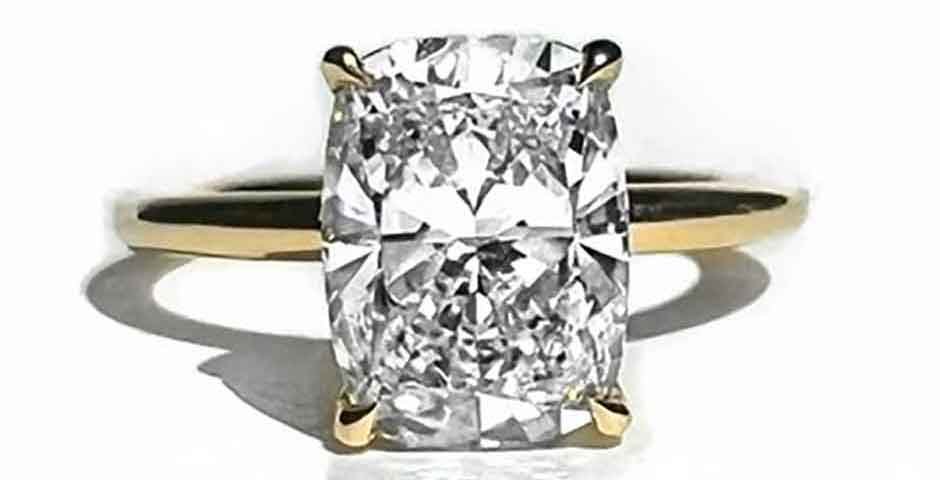Choosing an engagement ring can be overwhelming, and understanding the quality of the diamonds you choose for your engagement ring is crucial to making an informed choice. When buying a diamond engagement ring, you need to pay attention to a variety of things.
Many buyers keep their focus on their budget, their preference, ring size, and diamond size. But when it comes to picking the best diamond for an engagement or wedding ring, you also have to pay proper attention to the Four C’s of diamonds. Understanding the Four C’s of diamonds – cut, color, clarity, and carat weight and considering them properly during the purchase not only just helps you choose the right diamonds but also lowers the risk of making a hole in the pocket.

The Four C’s- cut, color, clarity, and carat weight of the diamond are four factors, attention to which not only just help you understand the quality of your engagement ring but also make it easy for you to order the best custom ring. This also affects your purchase decision and makes it easy for you to choose the diamond that will go perfectly with your engagement ring. Let’s explore each of these factors so you can easily understand the quality of your engagement ring.
Cut
The first thing that needs attention when choosing a diamond for an engagement ring is the diamond cut. The cut of a diamond defines its proportions. It defines its symmetry, and polish. A diamond that is well-cut reflects light from every angle. It creates a brilliant sparkle. But on the other side, a poorly cut diamond does not reflect light and thus results in a dull appearance. With this, the cut of a diamond plays a major role in determining its overall beauty.
The cut of the diamond you choose has a significant impact on the brilliance, fire, and scintillation of the diamond. Based on the cut quality, diamonds are graded on a scale from excellent to poor. The cut of a diamond you choose for the engagement ring can affect its value by up to 50%. This also makes it an important factor to consider.
Color
The color of a diamond refers to the absence or presence of color in a diamond. Diamonds that are colorless or nearly colorless are considered the most valuable diamonds. A colorless diamond allows the most light to pass through and reflect back to the viewer. With this, such diamonds create a brilliant sparkle.
A higher color grade diamond is considered more valuable, but slight differences in the color of the diamond may not be noticeable to the naked eye. In terms of color, diamonds are graded on a scale from D to Z, in which D is known as being completely colorless and Z is known for having a noticeable yellow or brown tint. The color of a diamond also affects its value by up to 20%.
Clarity
The clarity of a diamond defines the absence or presence of blemishes and inclusions. Blemishes are external imperfections and inclusions are internal imperfections that affect the appearance of the diamond. An engagement ring that includes a diamond with fewer blemishes or inclusions is considered more valuable. This is because this type of diamond allows more light to pass through it, and create a more brilliant sparkle.
The imperfections are graded on a scale from Flawless, i.e. no blemishes or inclusions that are visible under 10x magnification, to Included, i.e. blemishes or inclusions that are visible to the naked eye. Along with the blemishes and inclusions, the size and location of the blemishes or inclusions and their number must also be considered when evaluating the clarity of a diamond. The clarity of a diamond can affect its value by up to 40%.

Carat
No matter whether you are looking for an emerald cut or a cushion cut engagement ring, the carat of the diamond also needs equal attention like its color, clarity, and cut. The carat weight of a diamond is the measure of its mass. It refers to its weight. One carat is considered equivalent to 0.2 grams or 200 milligrams.
Usually, the size of a diamond and its carat weight is not always the same. The cut, shape, and depth of the diamond can affect its apparent size. Diamonds are usually sold in fractions of a carat. With the increase in the diamond weight, their value also increases. A larger diamond is typically more valuable than a smaller diamond because it is rare. Along with this, the weight of all the diamonds in a piece of jewelry, the shape of the diamond, such as round or princess, and the weight of the largest diamond in the engagement ring also must be considered when evaluating the carat weight of a diamond.
Final Thoughts
The Four C’s of diamonds are the most important factors to consider when evaluating the quality of a diamond. It is always better to understand how these factors impact the value as well as the appearance of the diamond. Along with choosing the right jeweler for the purchase of your diamond engagement ring, you must consider which of these factors are most important to you and your partner.






